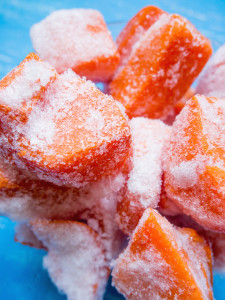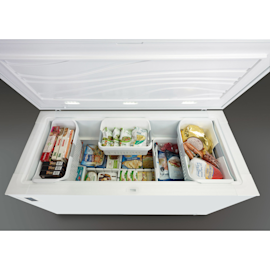7 tips to prevent freezer burn


You stock up on steaks during a winter sale. You wait 4 months for grilling season. You eagerly extract the steaks from the freezer—only to find that they’re brown and shriveled. That, dear reader, is the heartbreak of freezer burn.
Freezer burn happens when air reaches the surface of frozen foods, creating patches that are dry and discolored. Although freezer-burned foods are safe to eat, the leathery texture and degraded flavor make them less appealing (might be time for a stew!).
Here's how to save your food from freezer burn.
Keep the freezer temperature at 0°F. When the freezer temperature goes up, frozen food releases moisture, which forms ice crystals when the temperature drops again. Which leads us to the next tip...
Let food cool in the refrigerator before moving it to the freezer. Consider it a time-out that keeps hot foods from increasing the freezer temperature.
Plastic wrap doesn't cling to itself as well when cold, so tightly double wrap the food. Plastic wrap manufacturers suggest keeping foods for no longer than 2 weeks if wrapped in plastic.

When freezing food in plastic storage containers, fill to the top to leave less room for air. And "burp" the container by opening one edge of the lid slightly while pushing down on the center of the lid.
Remove as much air as you can from zip-top plastic storage bags before sealing. Should you invest in freezer bags? Opinions vary. Regular and freezer bags both are made of low-density polyethylene; freezer bags are thicker, so they let in less air over time. For long-term storage (and for extra durability) you might want to spring for freezer bags. For short-term storage, regular bags are fine.
If you have a stand-alone freezer where you store food for a long time, consider investing in a vacuum sealer to make sure no air can reach the food surface.
Time is the enemy of frozen food, no matter how well you wrap it. Label each food container with the date you put it in the freezer and use older foods first. You might find it helpful to move older food to the front of the freezer. Some people go so far as to keep a list of what's in the freezer and when it was added.
Most common symptoms to help you fix your freestanding freezers
Choose a symptom to see related freezer repairs.
Main causes: lack of power, bad compressor, refrigerant leak, bad thermistor, defrost system failure, dirty condenser co…
Main causes: burned out light bulb, bad door or lid switch, faulty LED light board, wiring failure, control system failu…
Main causes: compressor failure, no refrigerant, faulty sensor, control failure, broken defrost heater, bad defrost bi-m…
Main causes: damaged door or lid gasket, cracked cabinet liner, bad defrost bi-metal thermostat, broken defrost heater, …
Main causes: dirty condenser coils, condenser fan failure, dirty bottom front grill, leaky door or lid gasket…
Main causes: excessive frost, bad defrost heater, bad defrost bi-metal, control system failure, low refrigerant charge, …
Main causes: lack of power, control system failure, broken compressor start relay, locked up compressor, compressor moto…
Main causes: leaky door or lid gasket, broken defrost heater, bad defrost bi-metal thermostat, defrost control failure, …
Most common repair guides to help fix your freestanding freezers
Effective articles & videos to help repair your freestanding freezers
Use the advice and tips in these articles and videos to get the most out of your freezer.

Learn about all the convenient features on our Sears PartsDirect website that make your parts purchases easier.…

Get answers to frequently asked questions about Sears and Sears PartsDirect.…

Benefit from other people's experience by checking on these frequently asked questions about freezers.…
